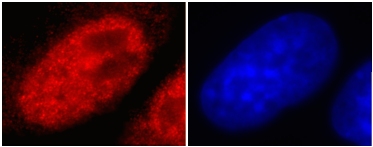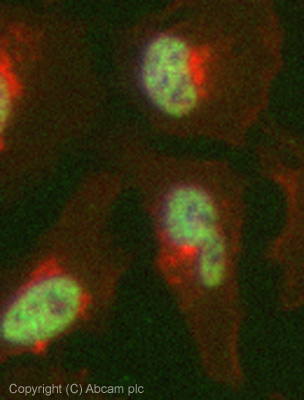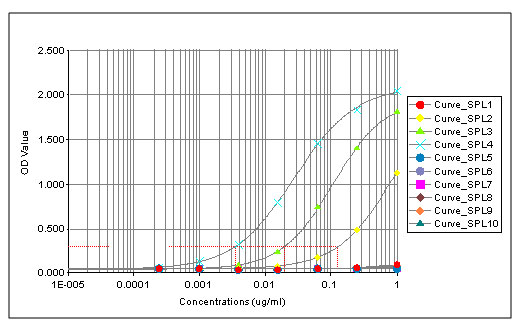Anti-Histone H3 (tri methyl K4) antibody [mAbcam1012] - ChIP Grade
| Name | Anti-Histone H3 (tri methyl K4) antibody [mAbcam1012] - ChIP Grade |
|---|---|
| Supplier | Abcam |
| Catalog | ab1012 |
| Prices | $394.00 |
| Sizes | 100 µg |
| Host | Mouse |
| Clonality | Monoclonal |
| Isotype | IgG2b |
| Clone | mAbcam1012 |
| Applications | ChIP FC ICC/IF ICC/IF IHC-F WB ICC/IF |
| Species Reactivities | Mouse, Rat, Bovine, Human, Zebrafish, Rice, Sheep, Xenopus, Arabidopsis thaliana, C. elegans, Drosophila, S. pombe, Mammalian |
| Antigen | Synthetic peptide corresponding to Human Histone H3 aa 1-100 (tri methyl K4) conjugated to Keyhole Limpet Haemocyanin (KLH) (Cysteine residue) |
| Description | Mouse Monoclonal |
| Gene | HIST3H3 |
| Conjugate | Unconjugated |
| Supplier Page | Shop |
Product images
Product References
H3K27me3 and H3K4me3 chromatin environment at super-induced dehydration stress - H3K27me3 and H3K4me3 chromatin environment at super-induced dehydration stress
Liu N, Fromm M, Avramova Z. Mol Plant. 2014 Mar;7(3):502-13.
Different gene-specific mechanisms determine the 'revised-response' memory - Different gene-specific mechanisms determine the 'revised-response' memory
Liu N, Ding Y, Fromm M, Avramova Z. Nucleic Acids Res. 2014 May;42(9):5556-66.
PADI4 acts as a coactivator of Tal1 by counteracting repressive histone arginine - PADI4 acts as a coactivator of Tal1 by counteracting repressive histone arginine
Kolodziej S, Kuvardina ON, Oellerich T, Herglotz J, Backert I, Kohrs N, Buscato El, Wittmann SK, Salinas-Riester G, Bonig H, Karas M, Serve H, Proschak E, Lausen J. Nat Commun. 2014 May 29;5:3995.
The RUNX2 cistrome in osteoblasts: characterization, down-regulation following - The RUNX2 cistrome in osteoblasts: characterization, down-regulation following
Meyer MB, Benkusky NA, Pike JW. J Biol Chem. 2014 Jun 6;289(23):16016-31.
Histone modifications are associated with Delta9-tetrahydrocannabinol-mediated - Histone modifications are associated with Delta9-tetrahydrocannabinol-mediated
Yang X, Hegde VL, Rao R, Zhang J, Nagarkatti PS, Nagarkatti M. J Biol Chem. 2014 Jul 4;289(27):18707-18.
Genomic determinants of gene regulation by 1,25-dihydroxyvitamin D3 during - Genomic determinants of gene regulation by 1,25-dihydroxyvitamin D3 during
Meyer MB, Benkusky NA, Lee CH, Pike JW. J Biol Chem. 2014 Jul 11;289(28):19539-54.
.
K-Lysine acetyltransferase 2a regulates a hippocampal gene expression network - K-Lysine acetyltransferase 2a regulates a hippocampal gene expression network
Stilling RM, Ronicke R, Benito E, Urbanke H, Capece V, Burkhardt S, Bahari-Javan S, Barth J, Sananbenesi F, Schutz AL, Dyczkowski J, Martinez-Hernandez A, Kerimoglu C, Dent SY, Bonn S, Reymann KG, Fischer A. EMBO J. 2014 Sep 1;33(17):1912-27.
Construction of mate pair full-length cDNAs libraries and characterization of - Construction of mate pair full-length cDNAs libraries and characterization of
Matsumoto K, Suzuki A, Wakaguri H, Sugano S, Suzuki Y. Nucleic Acids Res. 2014;42(16):e125.
Epigenetic reprogramming of cortical neurons through alteration of dopaminergic - Epigenetic reprogramming of cortical neurons through alteration of dopaminergic
Brami-Cherrier K, Anzalone A, Ramos M, Forne I, Macciardi F, Imhof A, Borrelli E. Mol Psychiatry. 2014 Nov;19(11):1193-200.



![Lane 1 : Anti-Histone H3 (tri methyl K4) antibody [mAbcam1012] - ChIP Grade (ab1012) at 1 µg/ml (Blocked in 5% BSA)Lane 2 : Anti-Histone H3 (tri methyl K4) antibody [mAbcam1012] - ChIP Grade (ab1012) at 1 µg/ml (Blocked in 5% MILK)Lane 1 : Calf Thymus Histone Preparation Nuclear Lysate Lane 2 : Calf Thymus Histone Preparation Nuclear Lysate Lysates/proteins at 0.5 µg per lane.SecondaryGoat polyclonal to Mouse IgG - H&L - Pre-Adsorbed (HRP) at 1/3000 dilutionPerformed under reducing conditions.](http://www.bioprodhub.com/system/product_images/ab_products/2/sub_3/2004_Histone-H3-Primary-antibodies-ab1012-19.jpg)
![All lanes : Anti-Histone H3 (tri methyl K4) antibody [mAbcam1012] - ChIP Grade (ab1012) at 2 µg/mlLane 1 : Calf Thymus Histone Preparation Nuclear Lysate Lane 2 : Calf Thymus Histone Preparation Nuclear Lysate with Human Histone H3 (unmodified ) peptide (ab7228) at 0.25 µg/mlLane 3 : Calf Thymus Histone Preparation Nuclear Lysate with Human Histone H3 (mono methyl K4) peptide (ab1340) at 0.25 µg/mlLane 4 : Calf Thymus Histone Preparation Nuclear Lysate with Human Histone H3 (di methyl K4) peptide (ab7768) at 0.25 µg/mlLane 5 : Calf Thymus Histone Preparation Nuclear Lysate with Human Histone H3 (tri methyl K4) peptide (ab1342) at 0.25 µg/mlLane 6 : Calf Thymus Histone Preparation Nuclear Lysate with Human Histone H3 (mono methyl K9) peptide (ab1771) at 0.25 µg/mlLane 7 : Calf Thymus Histone Preparation Nuclear Lysate with Human Histone H3 (di methyl K9) peptide (ab1772) at 0.25 µg/mlLane 8 : Calf Thymus Histone Preparation Nuclear Lysate with Human Histone H3 (tri methyl K9) peptide (a](http://www.bioprodhub.com/system/product_images/ab_products/2/sub_3/2005_Histone-H3-Primary-antibodies-ab1012-40.jpg)

![Overlay histogram showing HeLa cells stained with ab1012 (red line). The cells were fixed with 80% methanol (5 min) and then permeabilized with 0.1% PBS-Tween for 20 min. The cells were then incubated in 1x PBS / 10% normal goat serum / 0.3M glycine to block non-specific protein-protein interactions followed by the antibody (ab1012, 1µg/1x106 cells) for 30 min at 22ºC. The secondary antibody used was DyLight® 488 goat anti-mouse IgG (H+L) (ab96879) at 1/500 dilution for 30 min at 22ºC. Isotype control antibody (black line) was mouse IgG2b [PLPV219] (ab91366, 2µg/1x106 cells) used under the same conditions. Acquisition of >5,000 events was performed.](http://www.bioprodhub.com/system/product_images/ab_products/2/sub_3/2007_Histone-H3-Primary-antibodies-ab1012-67.jpg)